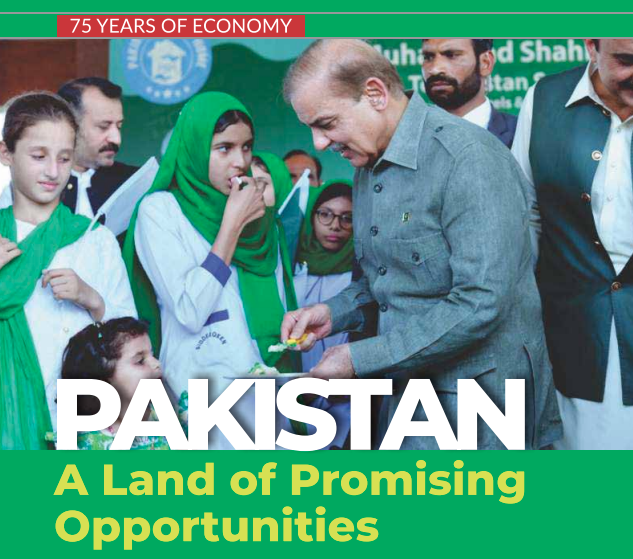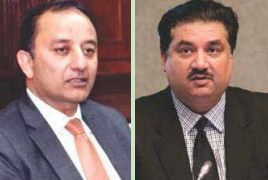
The Government is highly committed to introduce far-reaching reforms in every sector of the augment the economy of the country.
Dr. Imtiaz Ahmed
Pakistan is strategically located and it allows Pakistan to become an important trade, energy and transport corridor. Most importantly, Pakistan is a gateway to energy rich states of Central Asia, the Gulf States and far Eastern countries making Pakistan a place of endless opportunities and possibilities.
The determination of its people made the country world’s 24th largest economy in terms of purchasing power parity and 44th in terms of nominal GDP. In FY 2022, nominal GDP crossed Rs. 66,000 billion ($383 billion) whereas, per capita income reached at $1,798. According to World Bank estimates, Pakistan is among the top 10 recipients of remittances, which grew by 6.1 percent and raised to a record high $31.2 billion in Financial Year 2022.
High performing agriculture sector is the center piece of present government’s growth and poverty alleviation strategy and socio-economic uplift.
Major sectors of Pakistan’s economy are agriculture, industrial and services which contribute 22.7 percent, 19.1 percent and 58.2 percent respectively in GDP.

Globally, Pakistan is ranked 5th by International Cotton Advisory Committee (ICAC, 2021/22) in cotton production, 4th in sugarcane with 88.7 million tons and 7th in wheat production with 26.4 million tons, respectively. In term of natural resources, Pakistan is one of the resource rich countries in the world having abundant reserves of coal, gas, gemstones, copper, salt, minerals, and gold. Other resources include oil, iron and aluminum which are vital for any growing economy.
Pakistan is the 5th most populated country in the world with an estimated population of more than 224.7 million with labor force of 71.76 million. Pakistan has great opportunity of reaping demographic dividend because it has significant number of youth growing and making youth bulge. The increasing proportion of Pakistan’s youth bulge with diversified capabilities would be supportive in achieving sustainable economic growth. Government of Pakistan is making its best efforts to provide them adequate training, skill development and employment opportunities to tap the potential of the youth. Around 12 million Pakistanis are working abroad sending precious remittances worth billions of dollars.
Pakistan’s economy showed tremendous resilience to various internal and external shocks including the recent Covid-19, global economic meltdown, war against terrorism, energy shortfalls, natural disasters and political instability. These challenges have taken a major toll over the years on Pakistan’s economic growth but it withstands well.
Presently, the economy is characterized by mounting debt and liabilities, current account and budget deficit, depleting foreign exchange reserves, subdued growth in exports, high circular debt and poor performance of the state-owned enterprises. Government is taking initiatives and using all the available tools to break the cycle of recurring instability and to put the economy on the path of sustained growth and stability. Government is highly committed to introduce far-reaching reforms in every sector of the economy. The goal is to transform Pakistan into a land of opportunities.
Government is taking initiatives and using all the available tools to break the cycle of recurring instability and to put the economy on the path of sustained growth and stability.

The government is cognizant of these challenges and striving hard to cope with them through various measures. The government is focused on strengthening the economy, achieving price stability, and maintaining the sustainability of the external & fiscal sectors through various immediate measures.
To address the macroeconomic imbalances, contractionary monetary and fiscal policies are adopted by the government at the start of FY2023. The likely consequences include stabilization in real GDP growth rate; however, strong recovery of the economy is expected thereafter. The medium-term growth is expected to return to levels even higher than historical trends with average rates of 6.0 to 7.0 percent in FY24-25.
High performing agriculture sector is the center piece of present government’s growth and poverty alleviation strategy. It has a very prominent role to achieve goals of poverty alleviation and socio-economic uplift through inclusive growth of both farming and non-farming segments of rural economy. Production Estimates for Major Crops for FY 2023 indicates that better policies and favorable conditions will allow us to achieve production of cotton, rice, sugarcane, maize and minor crops.
The budget 2022-23 emphasized to increase agricultural productivity by increasing and improving land under cultivation. The government has taken various steps/initiatives for the development of agriculture sector. The government has allocated Rs. 21 billion to increase crop yield and uplift of livestock sector. With the consultation of provinces, the government has devised a three-year growth strategy with the aim to enhance production, increase farmers’ income, counter the negative effects of climate changes, promote smart agriculture, self-sufficiency, value addition and agro processing.
To provide a boost and further strengthen the industrial sector, Customs Duty, Additional Customs duty, and Regulatory Duty on around 400 tariff headings pertaining to different industrial/manufacturing sectors have been rationalized. The tariff structure has been rationalized for synthetic filament yarn to meet the long-standing demand of the textile sector. To provide uninterrupted power supply to industries, industrial feeders will be exempted from load-shedding.
Steps to provide essential infrastructure and services for special economic zones are initiated so that market share in domestic and international market can be enhanced. An amount of Rs. 5 billion has been allocated for value-added export based on the latest technology, mineral sector, and industry. Provision of electricity and gas to special economic zones to be made operational as soon as possible.
For the development of infrastructure, a total of Rs. 395 billion has been allocated. An amount of Rs. 73 billion has been provided for the power sector out of which Rs. 12 billion will be spent on the earlier completion of Mohamand Dam. An amount of Rs. 202 billion has been allocated for highways and seaports.

To promote investment in the country, a new strategy for an investor-friendly environment will be provided which includes reforms in Dispute Resolution Mechanism for citizens and foreign investors. International best practices will be adopted for the purpose which will include the alternate dispute resolution mechanism. These reforms will be introduced in consultation with the superior judiciary so that it could immediately be implemented. Nine special economic zones would be established on the CPEC route, and investors from China and other countries will be facilitated to set up factories in these economic zones.
The critical challenge faced by the government is the rapidly depleting foreign reserves. Government has succeeded in mobilizing financing from friendly countries in the form of short- to medium-term loans, deferred payment and debt roll-overs. These measures and inflows including historic remittances have stopped the declining rupee, strengthened Pakistan’s foreign exchange reserves and reduced external vulnerabilities. Pakistan’s exports during FY2022 stood at US$ 32 billion.
Government has taken immediate actions to boost exports including subsidized electricity and gas to industrial and export sectors, loans at lower interest rates, import duties on raw materials of export-oriented industries reduced. The impact of stabilization efforts, banning import for certain period and imposition of regulatory duties on non-essential imports reflects in quantum effect which declined import bill significantly.
Government is committed to implement structural reforms to narrow the fundamental revenue-expenditure gap. This will ensure an efficient and fair tax system with the ability to generate ample revenue to finance a large part of public expenditures. On revenue side, the fiscal strategy will focus on increasing revenue through broad-based tax policy and administration reforms to raise the tax to GDP ratio.
On expenditure side, the government is following prudent expenditure consolidation. The government is making strategy for cost recovery in energy and SOEs. The government is designing new SOEs’ Law aimed at modernizing and clearly defining the role of the State as owner, regulator, and shareholder of SOEs.
To attract FDI, government is inclined toward setting up of SEZs. The Government is also keen to set up export-processing zones (EPZs) to encourage foreign investment. Some of the incentives offered to EPZ investors include exemptions from all federal, provincial and municipal taxes for export-destined production, exemptions from all taxes and duties on equipment, machinery and materials and access to Export Processing Zone Authority “one window” services.
Pakistan has always proved to be the home of most resilient nation. It has all the requisites of being a major economic player in the region and Asia. Its economic potential is immense. Government is well aware of the challenges, Pakistan is currently confronting with and hence adopted comprehensive set of economic and structural reforms to lay the foundation of sustainable development and to transform Pakistan into an equitable land of endless opportunities.

The writer is Economic Adviser, Finance Division, Islamabad.

